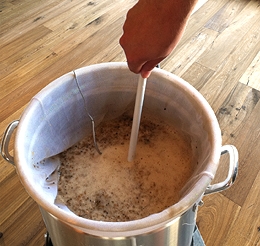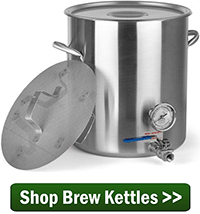 If you are an extract or partial mash homebrewer trying to get started with all-grain brewing, the “Brew-in-a-Bag” (BIAB) method is a great way to make the switch. It’s a little easier than the standard infusion mash, but the big advantage is that you eliminate the need for a separate mash tun (tun is just brew-talk for kettle). Instead of mashing the grains in a mash tun, recirculating your wort, and boiling it in another kettle, the Brew-in-a-Bag method allows you to do everything in one vessel.
If you are an extract or partial mash homebrewer trying to get started with all-grain brewing, the “Brew-in-a-Bag” (BIAB) method is a great way to make the switch. It’s a little easier than the standard infusion mash, but the big advantage is that you eliminate the need for a separate mash tun (tun is just brew-talk for kettle). Instead of mashing the grains in a mash tun, recirculating your wort, and boiling it in another kettle, the Brew-in-a-Bag method allows you to do everything in one vessel.
To set up your BIAB brewing system all you need is a mesh grain bag large enough to hold 10-12 lbs. of grain (for a 5 gallon batch). I also recommend a large strainer or colander that’s big enough to sit across the top of your kettle.
The main difference between BIAB and a standard all-grain brew is that the grains go in the bag and the bag comes out at the end of the mash. Removing the bag from the wort washes the grains and eliminates the need for a sparge.
How to “Brew-in-a-Bag” BIAB
- Clean & Sanitize. Just as you would otherwise, clean and sanitize all of your brewing equipment. I like to use One Step No Rinse Cleanser and Star San Sanitizer.
- Heat the mash water to 170°F. Start with your full boil volume. Knowing that some of your water will evaporate, use more water than however much beer you plan to make. For example, if making 5 gallons of beer, you might start with 6.5 gallons. Tip: If heating water on a kitchen stove, you may want to heat water in two pots to get up to temperature more quickly.
- Put your mesh brewing bag in the kettle and pour the crushed grains into the bag. Give the grains a good stir to avoid clumping. Hold the temperature between 150°F and 158°F to begin converting the starches in the grains into fermentable sugar. Tip: Use a bungie cord to hold the bag in place.

- Check the pH level. To convert the starches, your mash needs to be between 5.0 and 5.5 pH. If your pH is over 5.5, add a 1/4 teaspoon of gypsum to bring it down. If it’s under 5.0, add a 1/4 tsp. calcium carbonate. Adjust until you’re in range.
- Pull out the grain bag. This is the whole key to a brew in a bag system. After about 60 minutes, slowly pull out the bag and all the grains, taking care not to rip it. Set the bag over a strainer or colander so that the wort drains back into the pot, then discard the grains.
- Bring to a boil and add hops – Heat the wort to a roiling boil and start adding hops.
- From here, proceed as you would with any other method of brewing.
Have any questions about Brew in a Bag (BIAB) brewing system or homebrewing in general? Drop us a question in the comments!
Til next time…Cheers!
—–
David Ackley is a beer writer, brewer, and self-described “craft beer crusader.” He holds a General Certificate in Brewing from the Institute of Brewing and Distilling and is founder of the Local Beer Blog.

I’ve been doing a 5.5 gallon BIAB process for a while, and I notice the following:
I loose about 1-1/2 gallons of liquid after the mash. I rince the grain bag (sparge ?) with water at 170 Deg to get the volume back to 6-1/2 gallons. Is this normal for the process?
I’ve also noticed the my gravity is somewhat lower than my resipe states. Should I add more base grains than the resipe calls for to increase the gravity.
Thanks for your help
I think the reason your Specific gravity is off may be due to bringing the volume back up to 6.5 gallons. You may try checking your specific gravity before you rinse/sparge your grain bag. I usually just let mine drip or put rubber gloves on and squeeze out remainder depending on my time frame. I also very seldom bring volume back to more than 5 gallons.
PFlo
I like to “cold crash” about 3.5 gallons of wort, but usually can only get it down to 90 F. I then add filtered tap water to bring the temperature down to about 70 F. I assume 3.5 gal (with maybe an extra gal or so for evaporation) would be too small an amount for 10 lbs of grain. Or should I give it a try? Thanks.
Frank, in this case we would actually recommend cutting the recipe to 3.5 gallons. If you try to use the full recipe for 3.5 gallons, the liquid would be too thick to manage. It would also affect the amount of sugar that you extract from the grains.
I know the article says you don’t need to sparge, but if you split your mash water into two kettles and drop your grain bag into the sparge water for as little as 10 mins, it can increase your efficiency by as much as 10 percentage points.
I’ll usually start with 7 gallons. At mash out, I suspend the bag over the kettle to drain. While the wort is coming up to boil temp, I ladle 160-170 degree water over the bag to rinse the grain and bring my boil volume to 7 gallons. A good roiling boil will put it at 5.5 gallons to the primary. Since increasing the initial mash volume and adding the ladle sparge, I haven’t had any trouble reaching or even exceeding the target OG. Hope this helps.